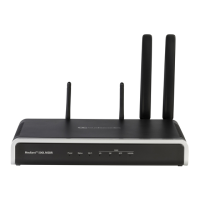User's Manual 264 Document #: LTRT-10466
Mediant 500L MSBR
19.1.2 Configuring Clock Synchronization between Device and SEM
To ensure accurate call quality statistics and analysis by the SEM server, you must
configure the device and the SEM server with the same clock source for clock
synchronization. In other words, you need to configure them with the same NTP server.
The NTP server can be one of the following:
AudioCodes EMS server (also acting as an NTP server)
Third-party, external NTP server
Once you have determined the NTP server, all the elements--device, SEM, and EMS--must
be configured with the same NTP server address.
To configure, the NTP server's address on the device, see ''Configuring Automatic Date
and Time using SNTP'' on page 131.
19.1.3 Enabling RTCP XR Reporting to SEM
In order for the device to be able to send voice metric reports to the SEM, you need to
enable the RTP Control Protocol Extended Reports (RTCP XR) VoIP management
protocol. RTCP XR defines a set of voice metrics that contain information for assessing
VoIP call quality and diagnosing problems. Enabling RTCP XR means that the device can
send RTCP XR messages, containing the call-quality metrics, to the SEM server.
For enabling RTCP XR reporting, see ''Configuring RTCP XR'' on page 705. For
configuring what to report to the SEM, see ''Configuring Quality of Experience Profiles'' on
page 264.
19.2 Configuring Quality of Experience Profiles
The Quality of Experience feature lets you monitor the quality of voice calls traversing the
device in your network. Voice-metric monitoring profiles (Quality of Experience Profiles)
can be configured and applied to specific network links, including IP Groups (see
''Configuring IP Groups'' on page 287), Media Realms (see ''Configuring Media Realms'' on
page 275), and Remote Media Subnets (see ''Configuring Remote Media Subnets'' on
page 278).
The monitored voice metrics include the following:
Mean Opinion Score (MOS): MOS is the average grade on a quality scale,
expressed as a single number in the range of 1 to 5, where 1 is the lowest audio
quality and 5 the highest audio quality.
Delay (or latency): Time it takes for information to travel from source to destination
(round-trip time).
Packet Loss: Lost packets are RTP packets that are not received by the voice
endpoint. Packet loss can result in choppy voice transmission.
Jitter: Jitter can result from uneven delays between received voice packets. To space
evenly, the device's jitter buffer adds delay. The higher the measurement, the greater
the impact of the jitter buffer's delay on audio quality.
Residual Echo Return Loss (RERL): An echo is a reflection of sound arriving at the
listener at some time after the sound was initiated (often by the listener). Echo is
typically caused by delay.
At any given time during a call, a voice metric can be in one of the following color-coded
quality states:
Green: Indicates good call quality
Yellow: Indicates medium call quality
Red: Indicates poor call quality

